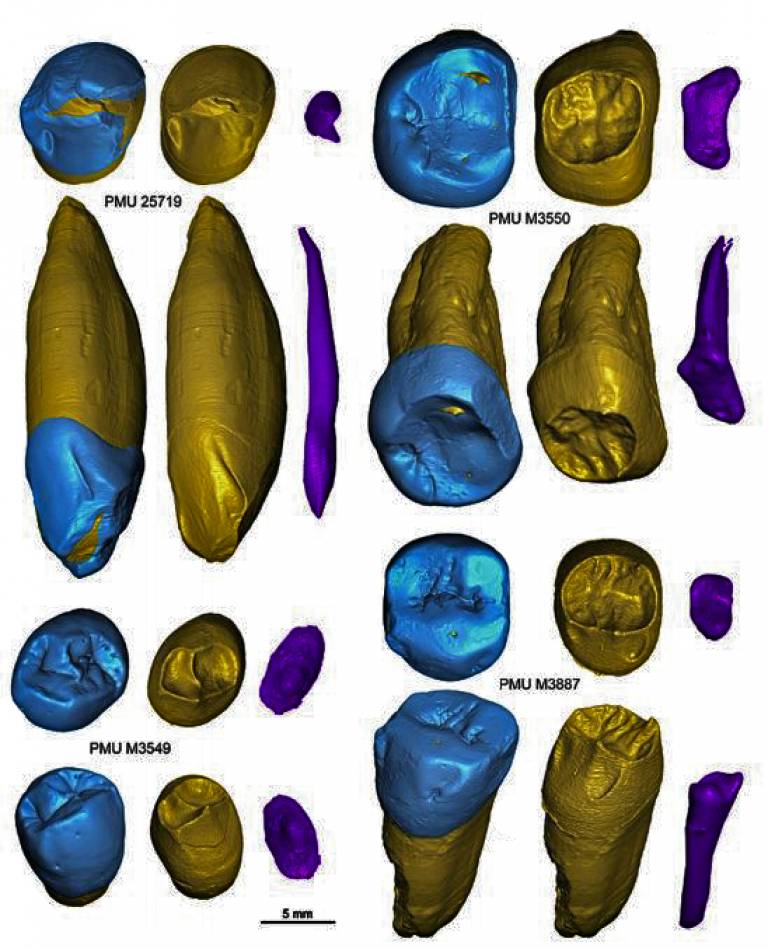Zhoukoudian's Homo erectus teeth provide some clues to the evolution of Homo erectus in South-east Asia
10 February 2018
Locality 1, in the Lower Cave of the Zhoukoudian cave complex, China, is one of the most important Middle Pleistocene paleoanthropological and archaeological sites worldwide, with the remains of c.
 45 Homo erectus individuals, 98 mammalian taxa, and thousands of lithic tools recovered. Most of the material collected before World War II was lost. However, besides two postcranial elements rediscovered in China in 1951, four human permanent teeth from the 'Dragon Bone Hill,' collected by O. Zdansky between 1921 and 1923, were at the time brought to the Paleontological Institute of Uppsala University, Sweden, where they are still stored. This small sample consists of an upper canine (PMU 25719), an upper third molar (PMU M3550), a lower third premolar crown (PMU M3549), and a lower fourth premolar (PMU M3887). Some researchers have noted the existence of morpho-dimensional differences between the Zhoukoudian and the H. erectus dental assemblage from Sangiran, Java. However, compared to its chrono-geographical distribution, the Early to Middle Pleistocene dental material currently forming the Chinese-Indonesian H. erectus hypodigm is quantitatively meager and still poorly characterized for the extent of its endostructural variation. We used micro-focus X-ray tomography techniques of virtual imaging coupled with geometric morphometrics for comparatively investigating the endostructural conformation (tissue proportions, enamel thickness distribution, enamel-dentine junction morphology, pulp cavity shape) of the four specimens stored in Uppsala, all previously reported for their outer features. The results suggest the existence of time-related differences between continental and insular Southeast Asian dental assemblages, the Middle Pleistocene Chinese teeth apparently retaining an inner signature closer to the likely primitive condition represented by the Early Pleistocene remains from Java, while the Indonesian stock evolved toward tooth structural simplification.
45 Homo erectus individuals, 98 mammalian taxa, and thousands of lithic tools recovered. Most of the material collected before World War II was lost. However, besides two postcranial elements rediscovered in China in 1951, four human permanent teeth from the 'Dragon Bone Hill,' collected by O. Zdansky between 1921 and 1923, were at the time brought to the Paleontological Institute of Uppsala University, Sweden, where they are still stored. This small sample consists of an upper canine (PMU 25719), an upper third molar (PMU M3550), a lower third premolar crown (PMU M3549), and a lower fourth premolar (PMU M3887). Some researchers have noted the existence of morpho-dimensional differences between the Zhoukoudian and the H. erectus dental assemblage from Sangiran, Java. However, compared to its chrono-geographical distribution, the Early to Middle Pleistocene dental material currently forming the Chinese-Indonesian H. erectus hypodigm is quantitatively meager and still poorly characterized for the extent of its endostructural variation. We used micro-focus X-ray tomography techniques of virtual imaging coupled with geometric morphometrics for comparatively investigating the endostructural conformation (tissue proportions, enamel thickness distribution, enamel-dentine junction morphology, pulp cavity shape) of the four specimens stored in Uppsala, all previously reported for their outer features. The results suggest the existence of time-related differences between continental and insular Southeast Asian dental assemblages, the Middle Pleistocene Chinese teeth apparently retaining an inner signature closer to the likely primitive condition represented by the Early Pleistocene remains from Java, while the Indonesian stock evolved toward tooth structural simplification.
Inner tooth morphology of Homo erectus from Zhoukoudian. New evidence from an old collection housed at Uppsala University, Sweden
Clément Zanolli, Lei Pan, Jean Dumoncel, Ottmar Kullmerd, Martin Kundrát, Wu Liu, Roberto Macchiarelli, Lucia Mancini, Friedemann Schrenk, Claudio Tuniz
DOI: 10.1016/j.jhevol.2017.11.002
 Close
Close

